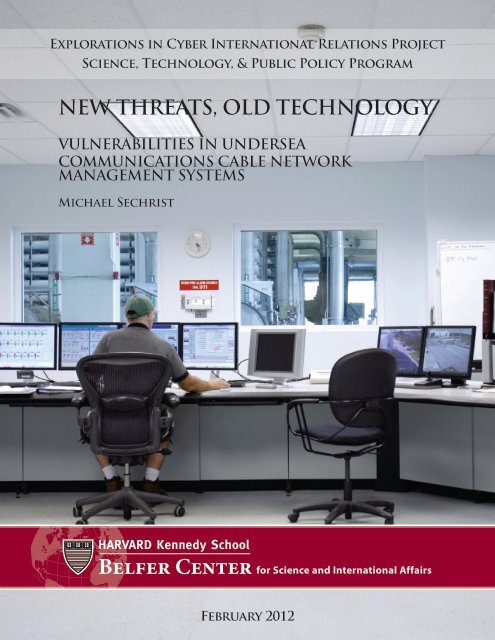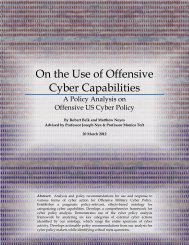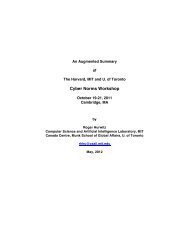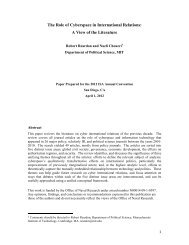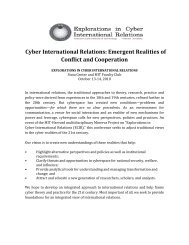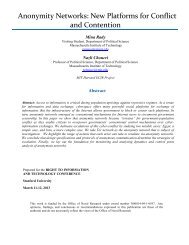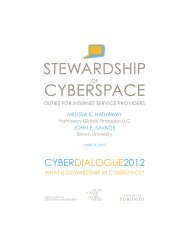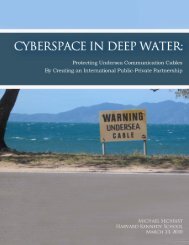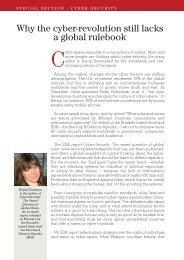new threats, old technology - Belfer Center for Science and ...
new threats, old technology - Belfer Center for Science and ...
new threats, old technology - Belfer Center for Science and ...
You also want an ePaper? Increase the reach of your titles
YUMPU automatically turns print PDFs into web optimized ePapers that Google loves.
Explorations in Cyber International Relations Project<br />
<strong>Science</strong>, Technology, & Public Policy Program<br />
NEW THREATS, OLD TECHNOLOGY<br />
VULNERABILITIES IN UNDERSEA<br />
COMMUNICATIONS CABLE NETWORK<br />
MANAGEMENT SYSTEMS<br />
Michael Sechrist<br />
February 2012
NEW THREATS, OLD TECHNOLOGY<br />
VULNERABILITIES IN UNDERSEA<br />
COMMUNICATIONS CABLE NETWORK<br />
MANAGEMENT SYSTEMS<br />
MICHAEL SECHRIST<br />
FEBRUARY 2012
Discussion Paper #2012-03<br />
<strong>Science</strong>, Technology, & Public Policy Program Discussion Paper Series<br />
Explorations in Cyber International Relations Project<br />
<strong>Belfer</strong> <strong>Center</strong> <strong>for</strong> <strong>Science</strong> <strong>and</strong> International Affairs<br />
Harvard Kennedy School<br />
79 JFK Street<br />
Cambridge, MA 02138<br />
Fax: (617) 495-8963<br />
Email: belfer_center@harvard.edu<br />
Website: http://belfercenter.org<br />
This document appears as Discussion Paper #2012-03 of the <strong>Belfer</strong> <strong>Center</strong> Discussion Paper<br />
Series. <strong>Belfer</strong> <strong>Center</strong> Discussion Papers are works in progress. Comments are welcome <strong>and</strong> may<br />
be addressed to the author at michael_sechrist@hks.harvard.edu.<br />
This work is funded by the Office of Naval Research under award number N00014-09-1-0597.<br />
Any opinions, findings, <strong>and</strong> conclusions or recommendations expressed in this publication are<br />
those of the author <strong>and</strong> do not necessarily reflect the views of the Office of Naval Research.<br />
Copyright 2012 President <strong>and</strong> Fellows of Harvard College<br />
The author(s) of this discussion paper invite liberal use of the in<strong>for</strong>mation provided in it <strong>for</strong><br />
educational purposes, requiring only that the reproduced material clearly state: Reproduced from<br />
Michael Sechrist, “New Threats, Old Technology: Vulnerabilities in Undersea Communication<br />
Cable Network Management Systems.” <strong>Belfer</strong> <strong>Center</strong> Discussion Paper, No. 2012-03, Harvard<br />
Kennedy School, February 2012.<br />
Statements <strong>and</strong> views expressed in this discussion paper are solely those of the author <strong>and</strong> do not<br />
imply endorsement by Harvard University, the Harvard Kennedy School, or the <strong>Belfer</strong> <strong>Center</strong> <strong>for</strong><br />
<strong>Science</strong> <strong>and</strong> International Affairs.
ACKNOWLEDGEMENTS<br />
The author would like to thank Venky Narayanamurti, Laura Diaz-Anadon, Zachary Tumin, <strong>and</strong><br />
the Harvard Kennedy School In<strong>for</strong>mation <strong>and</strong> Communication Technology Public Policy research<br />
fellows, specifically Lucas Kello <strong>and</strong> Vivek Mohan, <strong>for</strong> their helpful comments <strong>and</strong> support in<br />
editing this paper. Many thanks as well to James Smith, Susan Lynch, Patricia McLaughlin <strong>and</strong><br />
Traci Farrell <strong>for</strong> their work all through the <strong>for</strong>matting <strong>and</strong> production process.
ABSTRACT<br />
Undersea cables are among the most critical technologies supporting today’s global data <strong>and</strong><br />
voice communications. Long-st<strong>and</strong>ing physical vulnerabilities to attack persist: cable l<strong>and</strong>ing<br />
stations, <strong>for</strong> example, cluster high-value cable systems at single geographic points, but without<br />
the physical protections provided to other critical infrastructure such as telecommunication data<br />
centers. With an increasing number of cable operators using remotely-controlled network<br />
management systems, operators have introduced additional risk of large-scale cyber attacks,<br />
adding <strong>new</strong> urgency to securing all potential points of compromise, both the physical sites <strong>and</strong><br />
well as the logical infrastructure. While individually governments <strong>and</strong> industries have taken<br />
some steps to address such matters, much work remains. Collaboration on <strong>for</strong>tifying security<br />
with <strong>new</strong> regulatory <strong>and</strong> voluntary action, working through existing bodies such as Team<br />
Telecom under the Committee on Foreign Investment in the United States, <strong>and</strong> the International<br />
Cable Protection Committee, should accelerate.
TABLE OF CONTENTS<br />
Introduction. .................................................................................................................................. 6<br />
Brief Background on Undersea Communication Cable Systems .............................................. 8<br />
Criticality of Undersea Cables. ................................................................................................... 8<br />
Cables <strong>and</strong> the Financial Services Industry ................................................................................ 9<br />
Cable L<strong>and</strong>ing Sites: Exposures <strong>and</strong> Risks ............................................................................... 10<br />
Enter Undersea Cable Network Management Systems ........................................................... 12<br />
New Capabilities, New Worries ................................................................................................ 12<br />
New Systems, Old Vulnerabilities ............................................................................................ 13<br />
New Systems, New Vulnerabilities? ......................................................................................... 14<br />
Summing Up: Old Problems, New Vulnerabilities ................................................................... 15<br />
A Problem In Need of a Response: Domestic Policy Considerations ...................................... 16<br />
Global Collaboration <strong>for</strong> Cable Security................................................................................... 17<br />
Appendix A: Profile of Cyber Vulnerabilities in Three Major Management Systems. ........ 18<br />
Appendix B: Other Critical Infrastructure Attacks. ............................................................... 22<br />
New Threats, Old Technology<br />
Vulnerabilities in Undersea Communications Cable Network<br />
Management Systems<br />
5
INTRODUCTION<br />
Many cyber experts predict 2012 will usher in a <strong>new</strong> era of malware attacks on critical<br />
infrastructure systems. The predictions follow reports that the Stuxnet worm may have at least<br />
“four cousins,” several of which have yet to be fully identified. 1<br />
Security firms now rank cyber attacks on industrial supervisory control <strong>and</strong> data acquisition<br />
(“SCADA”) systems, which control everything from power to water, as among top <strong>threats</strong>.<br />
Surveying the field, McAfee concluded there was “little good <strong>new</strong>s about cybersecurity [<strong>and</strong>] the<br />
2<br />
crucial services that depend on in<strong>for</strong>mation <strong>technology</strong> <strong>and</strong> industrial control systems.” Control<br />
systems, McAfee said, especially those connected to the Internet, introduce “significant<br />
vulnerabilities into systems never designed to sustain suck risks.” 3<br />
Those vulnerabilities now proliferate. Conferees at January 2012’s International Conference on<br />
Cyber Security heard reports of the discovery in 2011 of 147 so-called “zero-day vulnerabilities”<br />
4<br />
– unpatched flaws – in Siemens-based SCADA systems. In December 2011, the U.S.<br />
Department of Homel<strong>and</strong> security issued an alert: it had discovered “researchers” using a <strong>new</strong><br />
search engine called “SHODAN”. SHODAN’s purpose: search <strong>and</strong> find Internet-facing control<br />
systems. 5<br />
The risk is real. In Texas, a hacker posted screen shots to the Internet of a SCADA system<br />
6<br />
monitoring a water treatment plant in South Houston. In late 2011, DHS Secretary Janet<br />
Napolitano said hackers have “come close” to shutting down elements of U.S. infrastructure,<br />
1<br />
Jim Finkle, “Stuxnet Weapon Has At Least 4 Cousins: Researchers.” Reuters, December 28, 2011.<br />
Accessed at http://www.msnbc.msn.com/id/45809884/ns/<strong>technology</strong>_<strong>and</strong>_science-security/t/stuxnetweapon-has-least-cousins-researchers/#.TxTe05jkSS0<br />
2<br />
Stewart Baker, Natalia Filipiak, <strong>and</strong> Katrina Timlin, “In the Dark: Crucial Industries Confront Cyber<br />
Attacks,” McAfee, 2011. Accessed at<br />
https://portal.mcafee.com/downloads/General%20Documents/critical_infrastructure_report.pdf<br />
3<br />
Angela Moscaritolo, “A ‘Critical’ Turning Point: The Nation’s Critical Infrastructure.” SC Magazine,<br />
January 3 rd , 2012.<br />
4<br />
Sara Yin, “Is Your SCADA Vulnerable to a Cyber Attack? Call 1-800-USA-0DAY,” PC Magazine,<br />
January 11, 2012. Accessed at http://securitywatch.pcmag.com/none/292708-is-your-scada-vulnerable-to-acyber-attack-call-1-800-usa-0day<br />
5<br />
ICS-CERT, “ICS-ALERT-11-343-01- Control System Internet Accessibility,” December 9, 2011.<br />
Accessed here: http://www.us-cert.gov/control_systems/pdf/ICS-ALERT-11-343-01.pdf<br />
6<br />
Paul Roberts, “Was The Three Character Password Used To Hack South Houston's Water Treatment<br />
Plant A Siemens Default?,” Threat Labs: Kaspersky Lab Security News Service, November 22, 2011.<br />
Accessed at http://threatpost.com/en_us/blogs/was-three-character-password-used-hack-south-houstonswater-treatment-plant-siemens-default-11
apparently both Wall Street <strong>and</strong> transportation systems. 7 Hackers compromised SCADA<br />
systems in three cities, the FBI reported, <strong>and</strong> could have “theoretically dumped sewage into a<br />
lake, or shut off the power to a shopping mall.” 8<br />
With all the commotion, there exists now an abundance of regulation, advice – <strong>and</strong> confusion<br />
about what to do next. For all of the government’s ef<strong>for</strong>ts, <strong>for</strong> example, the U.S. Government<br />
Accountability Office reported in 2012 that “DHS <strong>and</strong> the other sector-specific agencies have not<br />
identified the key cybersecurity guidance applicable to or widely used in each of their respective<br />
9<br />
critical infrastructure sectors.”<br />
This paper explores the vulnerabilities to cyber attacks of infrastructure that today carries nearly<br />
all the world’s data <strong>and</strong> voice traffic: undersea communications cables. Long-st<strong>and</strong>ing physical<br />
vulnerabilities in cable infrastructure have been compounded by <strong>new</strong> risk found in the network<br />
management systems that monitor <strong>and</strong> control cable operations. Unlike an attack on a water<br />
treatment plant’s control systems, however, an attack on the cables’ control systems could<br />
devastate the world’s economies – presenting a different kind of Internet “kill switch” altogether<br />
– shutting down world commerce, <strong>and</strong> doing it all with the click of a mouse.<br />
7 Ed O’Keefe, “Janet Napolitano: Hackers Have ‘Come Close’ To Major Cyberattack,” The Washington<br />
Post, October 27, 2011. For further in<strong>for</strong>mation on other critical infrastructure cyber attacks, please see<br />
Appendix B.<br />
8 Hal Hodson, “Hackers accessed city infrastructure via SCADA – FBI,” In<strong>for</strong>mation Age, November 29,<br />
2011. Accessed at http://www.in<strong>for</strong>mation-age.com/channels/security-<strong>and</strong>continuity/<strong>new</strong>s/1676243/hackers-accessed-city-infrastructure-via-scada-fbi.thtml<br />
9 United States Government Accountability Office, “Cybersecurity Guidance Is Available, But More Can<br />
Be Done to Promote Its Use,” GAO-12-92, Dec 9, 2011<br />
New Threats, Old Technology<br />
Vulnerabilities in Undersea Communications Cable Network<br />
Management Systems<br />
7
BRIEF BACKGROUND ON UNDERSEA COMMUNICATION<br />
CABLE SYSTEMS<br />
Ever since the dot com bubble burst last decade, undersea communication cable operators have<br />
faced difficulties in generating a profitable business model. In the late 1990’s <strong>and</strong> early 2000’s,<br />
financial speculators invested heavily in building <strong>and</strong> deploying cables to accommodate the<br />
predicted Internet boom. When the bubble burst, global dem<strong>and</strong> <strong>for</strong> b<strong>and</strong>width fell, creating<br />
significant b<strong>and</strong>width glut, primarily on U.S. trans-oceanic routes. 10<br />
As other industries have, undersea cable operators turned to <strong>technology</strong> to drive costs down <strong>and</strong><br />
maintain profitability. Today, the undersea cable industry is finding better ways to connect itself<br />
over its own infrastructure. Network management systems, <strong>for</strong> example, help operators reduce<br />
personnel <strong>and</strong> management costs. Using remote, web-based technologies they connect cable<br />
systems, l<strong>and</strong>ing stations, spare depots, <strong>and</strong> other cable system components – all decreasing the<br />
need <strong>for</strong> humans in the equation.<br />
Connecting cable sites with software creates more efficiency <strong>and</strong> provides operators greater<br />
operational awareness. However, it creates potential <strong>new</strong> risk, particularly to cyber attacks.<br />
CRITICALITY OF UNDERSEA CABLES<br />
As a <strong>technology</strong> system with physical, logical, <strong>and</strong> human components, cables have long been a<br />
high-risk, single point of potential failure. For highly connected nations, both developing <strong>and</strong><br />
developed, the consequence of failure is higher today than ever, as global Internet traffic has<br />
surged, <strong>and</strong> much of the world’s commerce <strong>and</strong> security now relies on cable <strong>for</strong> nearly all its<br />
voice <strong>and</strong> data needs.<br />
Undersea communication cables are, in fact, the only <strong>technology</strong> that can transmit large amounts<br />
of b<strong>and</strong>widths across bodies of water at low latencies (delays) <strong>and</strong> low costs. In fact, undersea<br />
cable systems worldwide transmit nearly 99 percent of all trans-oceanic Internet <strong>and</strong> data<br />
traffic. 11 In the U.S., over 90 percent of international voice <strong>and</strong> data traffic is transmitted via<br />
fiber. 12<br />
10<br />
Stephan Beckert, “International Telecommunication Trends,” PTC Conference Presentation, January<br />
2011);<br />
11<br />
Declan McCullagh, “NSA Eavesdropping: How It Might Work,” ZDnet.com, February 7, 2006.<br />
Accessed at http://<strong>new</strong>s.zdnet.com/2100-1009_22-146683.html<br />
12<br />
Ibid.<br />
New Threats, Old Technology<br />
Vulnerabilities in Undersea Communications Cable Network<br />
Management Systems<br />
8
Little can substitute <strong>for</strong> cable. In the event of a catastrophic failure to the entire cable architecture,<br />
<strong>for</strong> example, satellites <strong>and</strong> other technologies would likely be able to recoup only a sliver of that<br />
capacity.<br />
With the world so dependent on cable systems, the <strong>technology</strong> needs to be among the most<br />
reliable in the world. Industry makes it so: cables are operational with up to “5 nines” reliability,<br />
or 99.999 percent of the time. Only highly critical systems such as space shuttle <strong>technology</strong> <strong>and</strong><br />
nuclear weapons security have similar reliability. 13<br />
High reliability comes at high cost. Since undersea cable deployment is expensive, <strong>for</strong>ces of<br />
history <strong>and</strong> economies of scale have, over time, concentrated cable l<strong>and</strong>ing sites in a few<br />
geographic areas. From GIS data, at least ten major cable chokepoints exist around the world<br />
today. For example, much of the U.S. trans-Atlantic b<strong>and</strong>width comes ashore in just a few<br />
locations within a 30-mile radius of New York City. 14 Some in the industry claim that nearly all<br />
that same trans-Atlantic traffic then funnels into one pipe under a single building in downtown<br />
Manhattan, contravening the popular belief of extraordinary redundancy <strong>and</strong> resiliency within<br />
today’s telecommunications infrastructure. 15<br />
CABLES AND THE FINANCIAL SERVICES INDUSTRY<br />
With respect to global financial flows, in particular, undersea communication cables are<br />
exceptionally important.<br />
• At a recent cable seminar, a U.S. Federal Reserve representative stated that<br />
cables carry an excess of $10 trillion a day in transactions. 16<br />
• The Society <strong>for</strong> Worldwide Interbank Financial Telecommunication (SWIFT)<br />
network uses undersea fiber-optic communications cables to transmit financial<br />
13 Karl Rauscher, Comments made at a ROGUCCI Seminar, New York City, November 10, 2011<br />
14 David Lloyd, “The Need For Physical Diversity For Submarine Cable Routing,” Hibernia Atlantic<br />
website. October 2008. Accessed at http://www.hiberniaatlantic.com/documents/DaveysCorneroct2008.pdf<br />
15 Michael Sechrist, “Cyberspace in Deep Water: Protecting Undersea Communications Cables By<br />
Creating an International Public-Private Partnership,” Harvard Kennedy School Policy Analysis Exercise,<br />
March 2010. Page 21. Accessed at<br />
http://belfercenter.ksg.harvard.edu/publication/20710/cyberspace_in_deep_water.html?breadcrumb=%2Fex<br />
perts%2F2223%2Fmichael_sechrist<br />
16 Seminar panel held on the Reliability of Global Undersea Communications Cable Infrastructure,<br />
G<strong>old</strong>man Sachs Headquarters, New York City, November 10, 2011<br />
New Threats, Old Technology<br />
Vulnerabilities in Undersea Communications Cable Network<br />
Management Systems<br />
9
data to more than 8,300 member financial institutions in 195 countries. 17<br />
In 2011,<br />
SWIFT’s network h<strong>and</strong>led nearly 15 million messages daily.<br />
• The CLS Bank operates the largest multi-currency cash settlement system in the<br />
world, trading over 1 million transactions <strong>and</strong> over $4.7 trillion dollars a day over<br />
18<br />
undersea cables.<br />
• The U.S. Clearing House Interbank Payment System processes over $1 trillion a<br />
19<br />
day to more than 22 countries<br />
With trillions traded daily, a multi-cable outage, especially in a regional financial hub, has<br />
enormous ramifications <strong>for</strong> the global financial order. History proves this. One need only recall<br />
the days following the terrorist attacks of September 11, 2001, when one day later Wall Street<br />
was ready to trade, the Fed was eager to get capital flowing back into the markets – but the<br />
telecommunications infrastructure had succumbed to catastrophic failure. The global markets<br />
20<br />
stood by, waiting.<br />
CABLE LANDING SITES: EXPOSURES AND RISKS<br />
While the financial services industry eventually moved to address this, there remain today<br />
numerous single points of physical risk: the places where cables make l<strong>and</strong>fall, often clustered<br />
regionally.<br />
The U.S. State Department listed the world’s cable l<strong>and</strong>ing sites as among the most critical of<br />
infrastructures <strong>for</strong> the United States. 21<br />
With good reason: by gaining access to terminals located<br />
within cable l<strong>and</strong>ing sites, or to control systems managing the fiber-optic wavelengths<br />
themselves, a hacker could acquire control over portions of international data <strong>and</strong> voice traffic<br />
<strong>and</strong>, potentially, the power to disrupt or degrade significant portions of states’ cyber<br />
infrastructure.<br />
17<br />
Douglas Burnett, “Cable Vision,” 2011 Proceedings, U.S. Naval Institute. Accessed at<br />
www.usni.org<br />
18<br />
Ibid.<br />
19<br />
Burnett, Cable Vision.<br />
20<br />
Detailed in the section, “Waiting <strong>for</strong> Verizon,” in William Bratton <strong>and</strong> Zachary Tumin,<br />
Collaborate or Perish! Reaching Across Boundaries in a Networked World. New York: R<strong>and</strong>om<br />
House. 2012.<br />
21<br />
Mark Clayton, “WikiLeaks List of ‘Critical’ Sites: Is It a ‘Menu <strong>for</strong> Terrorists’?,” The Christian<br />
<strong>Science</strong> Monitor, December 6, 2010. Accessed at http://www.csmonitor.com/USA/Foreign-<br />
Policy/2010/1206/WikiLeaks-list-of-critical-sites-Is-it-a-menu-<strong>for</strong>-terrorists<br />
New Threats, Old Technology<br />
Vulnerabilities in Undersea Communications Cable Network<br />
Management Systems<br />
10
That capability is prized by defense <strong>and</strong> intelligence agencies the world over. Nor are<br />
governments alone: cyber criminals, hackers, terrorists <strong>and</strong> other non-state actors are determined<br />
to acquire this capability.<br />
With the risk of attack <strong>and</strong> the cost of compromise high, it is critical that industry <strong>and</strong> government<br />
treat cable system physical security <strong>and</strong> access with the utmost seriousness <strong>and</strong> concern – even to<br />
the same “five nines” they accord other critical infrastructure, like nuclear power plants. To date,<br />
however, that has not occurred.<br />
New Threats, Old Technology<br />
Vulnerabilities in Undersea Communications Cable Network<br />
Management Systems<br />
11
ENTER UNDERSEA CABLE NETWORK MANAGEMENT<br />
SYSTEMS<br />
With <strong>old</strong> physical risks unaddressed <strong>and</strong> exacerbated by <strong>new</strong>, massive global reliance on cableborne<br />
data traffic, <strong>new</strong> logical risks to the undersea cable infrastructure have emerged to make<br />
matters worse. That <strong>new</strong> logical risk comes from the very network management systems<br />
(“NMS”) that operators have installed to manage their operations efficiently.<br />
NMS are not <strong>new</strong>. Vendors have marketed NMS in various <strong>for</strong>ms since at least the early 1990’s.<br />
Nonetheless, today’s versions are much more comprehensive than their predecessors, <strong>and</strong> more<br />
mainstream – <strong>and</strong> scarier.<br />
NEW CAPABILITIES, NEW WORRIES<br />
Network managements systems are offered by several firms, including the three major undersea<br />
cable layer-operators -- TE Subcom, NEC, <strong>and</strong> Alcatel-Lucent. In general, NMS gives operators<br />
centralized control over the cable network, its individual parts (or elements), <strong>and</strong> access to all via<br />
web-based plat<strong>for</strong>ms.<br />
Using its NMS, <strong>for</strong> example, operators can manage field elements of an undersea communication<br />
cable system from anywhere in the world. This includes the cables’ physical <strong>and</strong> optical layer,<br />
line terminal equipment, repeaters, branching units, l<strong>and</strong>ing stations <strong>and</strong> other network operation<br />
centers, even those residing in other nations.<br />
Today’s NMS have potent capabilities. For example, they allow <strong>for</strong> Reconfigurable Optical<br />
Add/Drop Multiplexing (“ROADM”). ROADM allows users to activate or remove optical<br />
wavelengths from a selected cable system. Using ROADM a system user could, <strong>for</strong> example,<br />
delete “the blue wavelength on channel 32” from a particular cable system. That wavelength<br />
might transmit all communications from Internet addresses belonging to a small country - like<br />
Yemen, Bahrain, or Estonia - to that l<strong>and</strong>ing site.<br />
Using ROADM, a user could remove all wavelengths on a particular cable, effectively shutting<br />
down large portions of data traffic <strong>for</strong> multiple states. And using its NMS, an operator can<br />
monitor wavelengths <strong>for</strong> “loss of light” situations due to faults, engineering malfunctions, or<br />
disruptions. But a hacker could direct a system to show the operator system condition “green”,<br />
when actually the system is blinking red. The consequence: an unauthorized user could siphon<br />
off wavelengths or create temporary disruptions without the operator knowing.<br />
New Threats, Old Technology<br />
Vulnerabilities in Undersea Communications Cable Network<br />
Management Systems<br />
12
NEW SYSTEMS, OLD VULNERABILITIES<br />
Within these systems, numerous cyber security concerns exist. Today, <strong>for</strong> example, NMS<br />
typically rely on HTTP, TCP/IP, Windows operating systems <strong>and</strong> web browsers like Microsoft<br />
Internet Explorer to connect to network operations centers <strong>and</strong> cable system field elements. It is<br />
reportedly “common practice to connect critical infrastructure systems to the Internet <strong>and</strong> then<br />
manage them with commonly available software.” 22<br />
It is also worrisome. Any system with web capabilities is an easier target <strong>for</strong> hackers than one that<br />
lacks them. The exploitable aspects of HTTP, Windows OS <strong>and</strong> Microsoft IE are, in fact,<br />
significant <strong>and</strong> well understood by cyber security experts.<br />
Not only are most NMS applications web-based, they are designed <strong>for</strong> computers running on<br />
Microsoft operating systems. Microsoft operating systems in particular are among the most<br />
attacked operating systems in the world 23<br />
.<br />
The risk to NMS <strong>and</strong> to cable operations there<strong>for</strong>e multiplies when the NMS “brain” – its<br />
supervisory control <strong>and</strong> data acquisition (SCADA) system - both runs Windows operating<br />
systems, <strong>and</strong> is connected to the Internet. Attackers can easily access <strong>and</strong> use Stuxnet-like code to<br />
attack most SCADA systems, particularly those based on legacy Siemens’ equipment. Two<br />
Windows applications exploits in particular reportedly still exist - one aimed at Siemens Simatic<br />
Manager <strong>and</strong> WinCC SCADA application; the other at Siemens S70-300 <strong>and</strong> 400 series<br />
24<br />
controllers.<br />
What is the nightmare scenario? A hacker penetrates a cable management system, gains<br />
administrative rights, <strong>and</strong> hacks into the presentation server. Presentation servers can host webbased<br />
applications <strong>for</strong> numerous cable operators <strong>and</strong> h<strong>and</strong>le management system data <strong>for</strong> multiple<br />
cable systems. Hacking into a presentation server can there<strong>for</strong>e provide attackers with access to<br />
control of multiple cable management systems. Hackers could then attain unprecedented toplevel<br />
views of multiple cable networks <strong>and</strong> data flows, discover physical cable vulnerabilities,<br />
<strong>and</strong> disrupt <strong>and</strong> divert data traffic. With that access, hackers/attackers can gain a potential “kill<br />
22<br />
McAfee Labs, 2012 Threat Predictions, accessed at http://www.mcafee.com/us/resources/reports/rpthreat-predictions-2012.pdf<br />
23 rd<br />
Trend Micro, “3 Quarter Quarterly Roundup,” November 2011. Page 5. Accessed at<br />
http://us.trendmicro.com/imperia/md/content/us/trendwatch/research<strong>and</strong>analysis/3q_2011_threat_roundup.<br />
pdf<br />
24<br />
Paul Roberts, “Many Stuxnet Vulnerabilities Still Unpatched,” ThreatPost: Kaspersky Lab Security<br />
News Service, June 8, 2011. Accessed at http://threatpost.com/en_us/blogs/many-stuxnet-vulnerabilitiesstill-unpatched-060811<br />
New Threats, Old Technology<br />
Vulnerabilities in Undersea Communications Cable Network<br />
Management Systems<br />
13
click” – with a click of a mouse they can delete wavelengths <strong>and</strong>, potentially, significantly disrupt<br />
or alter global Internet traffic routes.<br />
NEW SYSTEMS, NEW VULNERABILITIES?<br />
In March 2011, Nokia Siemens demonstrated its <strong>new</strong> undersea line terminal equipment, the hiT<br />
7300 plat<strong>for</strong>m. The Nokia Siemens NMS makes life easy <strong>for</strong> the customers. With it they have<br />
“remote network termination” capability, <strong>and</strong> “remote access [with] no system-specific knowhow<br />
or laptop required <strong>for</strong> any on-site installation, commissioning, provisioning.” 25<br />
Experts warn that Siemens equipment, <strong>new</strong> or legacy, should give cable operators pause.<br />
26<br />
Although Siemens has reportedly been at work repairing its compromised <strong>technology</strong>, it is<br />
unclear whether <strong>new</strong> Siemens-enabled products contain any of the control systems compromised<br />
in the Stuxnet attack. If they do, as recent reports suggest they might 27 , that could be a concern.<br />
Ralph Langner, the expert who decoded the Stuxnet worm, recently asserted that Stuxnet can<br />
easily be downloaded <strong>and</strong> copied into <strong>new</strong> <strong>for</strong>ms of attacks on SCADA systems. “Siemens<br />
customers,” cautioned Langner, “should be very concerned about attacks.” 28<br />
Cable operators may be left with few good choices. Only one major undersea cable provider, <strong>for</strong><br />
example, boasts of offering secure, integrated management software: Huawei Marine Networks.<br />
Uniquely among NMS providers, Huawei’s NMS claims use of HTTPS/SSL. It provides<br />
29<br />
“optional” access control tools <strong>and</strong> security tools to prevent hacking, viruses, <strong>and</strong> worms.<br />
If true, such protections may provide Huawei with first-mover advantage among cable operators<br />
in offering secure NMS. That is worrisome <strong>for</strong> the United States <strong>and</strong> its allies – particularly the<br />
30<br />
defense <strong>and</strong> intelligence communities. U.S. officials believe that <strong>for</strong>mer Peoples’ Liberations<br />
25 Nokia Siemens hiT 7300 Product Overview. Accessed at<br />
http://www.nokiasiemensnetworks.com/portfolio/products/transport-networks/optical-transport/hit-7300<br />
26 Paul Roberts, “Siemens Working on Fixing Security Gap in Logic Controllers,” ThreatPost: Kaspersky<br />
Lab Security News Service, May 24, 2011. Accessed at http://threatpost.com/en_us/blogs/siemensworking-fix-security-gaps-logic-controllers-052411<br />
27 Paul Roberts, “Update: Looking <strong>for</strong> a Firesheep, researchers lay bare woeful SCADA security,” January<br />
20, 2012. Accessed at http://threatpost.com/en_us/blogs/looking-firesheep-moment-researchers-lay-barewoeful-scada-security-<br />
012012?utm_source=Threatpost&utm_medium=Tabs&utm_campaign=Today%27s+Most+Popular<br />
28 Roberts, op cit.<br />
29 Ibid.<br />
30 US-China Economic <strong>and</strong> Security Review Commission (USCC), “The National Security Implications of<br />
Investment <strong>and</strong> Products from the People’s Republic of China in the Telecommunications Sector,” January<br />
2011<br />
New Threats, Old Technology<br />
Vulnerabilities in Undersea Communications Cable Network<br />
Management Systems<br />
14
Army (PLA) officials with direct connections to the Chinese military establishment run Huawei.<br />
The company <strong>and</strong> its products are matters of ongoing concern, <strong>and</strong> <strong>for</strong> the most part are not<br />
approved <strong>for</strong> use by any U.S. company, particularly companies operating critical or sensitive<br />
infrastructure. 31<br />
SUMMING UP: OLD PROBLEMS, NEW VULNERABILITIES<br />
Poor physical security of cable l<strong>and</strong>ing sites is a potential Achilles heel <strong>for</strong> U.S. <strong>and</strong> global cyber<br />
security. Cable l<strong>and</strong>ing sites have always been <strong>and</strong> continue to be single points of potentially<br />
catastrophic attack <strong>and</strong> failure that must be addressed.<br />
Today, however, risk to global safety <strong>and</strong> security is compounded by the vulnerability of cable<br />
systems to cyber attacks through <strong>new</strong> network management systems. These attacks can gain<br />
access to systems by exploiting physical vulnerabilities like those at cable l<strong>and</strong>ing sites, as well as<br />
by Internet-based vulnerabilities.<br />
With global commerce <strong>and</strong> security now nearly entirely dependent upon the security of this<br />
physical <strong>and</strong> logical infrastructure, the consequences of such failure could be devastating. A<br />
decade ago, <strong>for</strong>mer Secretary of State Condoleezza Rice stated, “The cyber economy is the<br />
economy. Corrupt those networks <strong>and</strong> you disrupt this nation.” 32<br />
Corrupting cable network<br />
management systems is surely a significant way to disrupt our national economy. Re<strong>new</strong>ed<br />
attention to both physical <strong>and</strong> logical security is urgently required.<br />
31<br />
Claude Barfield, “Telecoms <strong>and</strong> the Huawei conundrum: Chinese <strong>for</strong>eign direct investment in the United<br />
States.” American Enterprise Institute Economic Studies, November 16, 2011. Accessed at<br />
http://www.aei.org/files/2011/11/21/-telecoms-<strong>and</strong>-the-huawei-conundrum-chinese-<strong>for</strong>eign-directinvestment-in-the-united-states_170712239630.pdf<br />
32<br />
Condoleezza Rice, "Remarks to the Partnership <strong>for</strong> Critical<br />
Infrastructure," U.S. Chamber of Commerce," March 23, 2001, accessed at<br />
http://www.house.gov/jec/security.pdf<br />
New Threats, Old Technology<br />
Vulnerabilities in Undersea Communications Cable Network<br />
Management Systems<br />
15
A PROBLEM IN NEED OF A RESPONSE: DOMESTIC POLICY<br />
CONSIDERATIONS<br />
Today, the Committee on Foreign Investment in the United States (CFIUS), an inter-agency<br />
group chaired by the United States Treasury, has a direct role in reviewing all applications <strong>for</strong><br />
cable l<strong>and</strong>ing licenses. Through a CFIUS subgroup, dubbed “Team Telecom,” the U.S. reviews<br />
all undersea cable l<strong>and</strong>ing license applications <strong>for</strong> national security purposes. Ultimately, the<br />
Federal Communications Commission receives <strong>and</strong> must approve all such applications. The FCC<br />
refers all applications to Team Telecom <strong>for</strong> prior review. Applicants must clear Team Telecom’s<br />
33 34<br />
national security review be<strong>for</strong>e the FCC will consider granting a cable l<strong>and</strong>ing license.<br />
Team Telecom is there<strong>for</strong>e one of the most important gatekeepers in the U.S. regulatory scheme<br />
established to address the national security requirements <strong>for</strong> cable systems. As the U.S.<br />
government considers whether additional regulations might be required, Team Telecom could be<br />
the appropriate body to implement policies to minimize cyber security risks to cable systems.<br />
For starters, Team Telecom could m<strong>and</strong>ate that cable operators use secure management systems,<br />
or use them only with significant encryption/security protocols in place. Team Telecom should<br />
also ensure that computers operating cable management system software be patched continuously<br />
with the latest cybersecurity fixes in order to avoid glaring gaps.<br />
The group could require cable operators who use management systems to immediately upgrade<br />
security software in line with the most advanced security protections af<strong>for</strong>ded to other critical<br />
national infrastructure systems. High-security SCADA systems are on the market. For instance,<br />
one company recently launched an “ultra secure 3rd generation networked SCADA system,”<br />
which uses a “mutual authentication system to verify the remote management server <strong>and</strong> the<br />
controller to each other be<strong>for</strong>e allowing the software to be upgraded on the remote SCADA<br />
device.” 35<br />
Such systems seek to stem the rising SCADA vulnerabilities by protecting it from<br />
33<br />
Kent Bressie, “More Unwritten Rules: Developments in U.S. National Security Regulation of Undersea<br />
Cable Systems,” Presentation to the 2009 PTC conference, January 18, 2009. Accessed at<br />
http://www.harriswiltshire.com/siteFiles/News/7DF1C8D035660E8FBEF0AAC7BA8DA103.pdf<br />
34 Kent Bressie, “New Barriers to U.S. Market Entry <strong>for</strong> Undersea Cable Operators: Recent Developments<br />
with 'Team Telecom’,” Presentation to the 2008 PTC conference, January 13, 2008. Accessed at<br />
www.ptc.org/ptc08/participants/speakers/papers/BressieFinalSlides.pdf<br />
35 “Cambridge company Launches Ultra-Secure 3rd Generation Networked SCADA System,”<br />
Darkreading.com, January 17, 2012. Accessed at http://www.darkreading.com/advanced<strong>threats</strong>/167901091/security/attacks-breaches/232400480/cambridge-company-launches-ultra-secure-3rdgeneration-networked-scada-system.html<br />
New Threats, Old Technology<br />
Vulnerabilities in Undersea Communications Cable Network<br />
Management Systems<br />
16
locally installed malware <strong>and</strong> securing the connection at all times.<br />
Further, Team Telecom could require cable operators to consider removing access to the<br />
ROADM portion of these systems, or increase security measures in order to get to them on<br />
management systems. Air gapping computers that are allowed to add/drop wavelengths from the<br />
Internet might be one cost effective way to safeguard that aspect.<br />
It might also be prudent <strong>for</strong> the U.S. government to provide some sort of financial incentives <strong>for</strong><br />
companies to help reduce the costs associated with improving network management system<br />
security. As a direct incentive, the U.S. Department of Homel<strong>and</strong> Security could provide<br />
monetary grants to the cable companies offering these products. As an indirect incentive, the<br />
U.S. Federal Communications Commission might be able to decrease the initial permitting costs<br />
cable operators pay to l<strong>and</strong> a system on U.S. soil.<br />
GLOBAL COLLABORATION FOR CABLE SECURITY<br />
Cable architecture spans the globe <strong>and</strong> acts as the arteries of the global digital infrastructure. No<br />
one nation or company can truly ensure high-level security, unless all are committed to doing so.<br />
This interdependence is one reason why cybersecurity problems are so frustratingly complex <strong>and</strong><br />
difficult to solve; the solution resides in near seamless state <strong>and</strong> non-state actor collaboration.<br />
The International Cable Protection Committee (ICPC) might provide a good venue to enact<br />
global security changes to management system software. About one hundred <strong>and</strong> twenty-five<br />
cable industry companies comprise the ICPC.<br />
Last year, the ICPC opened its membership to nation states. So far, Australia <strong>and</strong> Singapore have<br />
joined. With nation states joining, perhaps the time is right <strong>for</strong> ICPC to create an international<br />
norm in this area <strong>and</strong> recognize the threat cyber attacks pose to these systems. Today, the ICPC<br />
can recommend that its members’ implement secure management systems around the world.<br />
Tomorrow, members could be encouraged to sign a public, voluntary pledge to limit the spread of<br />
such attacks <strong>and</strong> the group could devote some measure of resources to ensuring those that take the<br />
pledge actually implement it. In this way, the ICPC leadership might use some of those<br />
resources to provide an external audit function to certify members’ use of secure software.<br />
New Threats, Old Technology<br />
Vulnerabilities in Undersea Communications Cable Network<br />
Management Systems<br />
17
APPENDIX A: A PROFILE OF CYBER VULNERABILITIES IN<br />
THREE MAJOR MANAGEMENT SYSTEMS<br />
PROFILE: NEC’s WebNSV UMS/EMS 36<br />
The NEC system controls multiple l<strong>and</strong>ing stations, such as the per-wavelength<br />
management of OADM branching units (BUs) <strong>and</strong> the switching of power feed paths, as<br />
well as the monitoring of faults over the entire system.<br />
The EMS … is highly extendible <strong>for</strong> monitoring up to 1,000 network elements (NE),<br />
including the LTE (Line Terminal Equipment), PFE (Power Feeding Equipment) <strong>and</strong><br />
RFTE (Remote Fiber Testing Equipment)<br />
Systems accessed on PC via web-based system with single sign-on authorization (i.e.<br />
username <strong>and</strong> password)<br />
“All components are written in Java <strong>and</strong> communicate through Remote Method<br />
Invocation protocol (RMI) whilst eXtended Markup Language XML is used <strong>for</strong><br />
configuration.”<br />
The EMS <strong>and</strong> UMS are connected via the inter-station data communication network<br />
(DCN) using Transmission Control Protocol/Internet Protocol (TCP/IP). The UMS also<br />
adopts a server/client configuration as do the EMS <strong>and</strong> runs Java programs. The server<br />
uses Linux as the operating system (OS) while the client’s OS supports Microsoft<br />
Windows.<br />
Encryption protocols between server <strong>and</strong> computer is currently “optional”<br />
All l<strong>and</strong>ing stations, even those unattended, can be monitored remotely from one<br />
location.<br />
36 In<strong>for</strong>mation on the NEC WebNSV UMS/EMS was collected from two conference reports presented at<br />
the 2010 SubOptic Conference: Ken-ichi Nomura, “NEC’s Unified <strong>and</strong> Element Management System <strong>for</strong><br />
an Advanced Undersea Cable Network,” SubOptic 2010 Poster Session, May 2010. Accessed at<br />
http://suboptic.org/App/Uploads/Files/Poster%20257%20Kenichi%20Nomura.pdf<br />
Ken-ichi Nomura, Yasuhiro Aoki, Taka-aki Takeda, “Unified & Element Management System <strong>for</strong><br />
Advanced Undersea Cable Network,” SubOptic 2010 conference paper, May 12, 2010. Accessed at<br />
http://suboptic.org/App/Uploads/Files/257_Poster_EC_05.pdf<br />
New Threats, Old Technology<br />
Vulnerabilities in Undersea Communications Cable Network<br />
Management Systems<br />
18
PROFILE: Alcatel-Lucent’s 1350 Optical Management System (OMS) 37<br />
The 1350 OMS provides the capability to start <strong>and</strong> stop applications independently, <strong>and</strong><br />
is available in compact or distributed configurations.<br />
Uses a common desktop, login <strong>and</strong> security; common GUI <strong>and</strong> maps; common fault<br />
management; <strong>and</strong> common PM.<br />
This architecture allows Alcatel- Lucent to provide a single system with single<br />
integration points <strong>for</strong> multiple optical network technologies <strong>and</strong> all network sizes.<br />
Equivalent <strong>technology</strong>-specific solutions would require four or five separate systems.<br />
Self-service supervision <strong>and</strong> control: where the network operator provides end-user selfserve<br />
facilities (to check own service connections; optionally to also setup/clear down).<br />
Graphical depictions of Alcatel-Lucent’s system, collected from the SubOptic conference<br />
paper, are found below. Note the web-based system is accessible via an HTTP URL with a<br />
single sign-on username <strong>and</strong> password, where it then connects to a presentation server. These<br />
servers can host in<strong>for</strong>mation related to several, unrelated cable systems.<br />
37 In<strong>for</strong>mation on Alcatel-Lucent’s 1350 OMS was collected from several documents:<br />
See “Alcatel-Lucent 1350 OMS Optical Management System,” Alcatel-Lucent Company Brochure.<br />
Accessed at http://www.alcatellucent.com/wps/DocumentStreamerServlet?LMSG_CABINET=LGS_Resources&LMSG_CONTENT_FIL<br />
E=Brochures/1350_OMS_R9-1_bro.pdf&lu_lang_code=en_WW,<br />
“Alcatel-Lucent 1350 Management Suite,” Alcatel-Lucent website. Accessed at http://www.alcatellucent.com/wps/portal/!ut/p/kcxml/04_Sj9SPykssy0xPLMnMz0vM0Y_QjzKLd4w3MfQFSYGYRq6mpEoYgbxjgiRIH1vfV-<br />
P_NxU_QD9gtzQiHJHR0UAAD_zXg!!/delta/base64xml/L0lJayEvUUd3QndJQSEvNElVRkNBISEvNl9<br />
BXzNBRC9lbl93dw!!?LMSG_CABINET=Solution_Product_Catalog&LMSG_CONTENT_FILE=Produc<br />
ts/Product_Detail_000328.xml#tabAnchor3<br />
Richard Cruau, “Web Based Undersea Management Solutions,” SubOptic 2010 conference paper, May<br />
2010. Accessed at http://suboptic.org/App/Uploads/Files/314_Poster_EC_11.pdf<br />
New Threats, Old Technology<br />
Vulnerabilities in Undersea Communications Cable Network<br />
Management Systems<br />
19
Graphical Representation of Alcatel-Lucent’s 1350 OMS<br />
(Source: Cruau, SubOptic 2010)<br />
New Threats, Old Technology<br />
Vulnerabilities in Undersea Communications Cable Network<br />
Management Systems<br />
20
PROFILE: TE SubComs’ Network Management System (TEMS-NMS) 38<br />
TEMS-NMS is “implemented primarily using C++ <strong>and</strong> Java programming languages”<br />
“…Executes on the Linux operating system using commercial off the shelf (COTS)<br />
hardware”<br />
“…A customer may access TEMS-NMS using Virtual Network Computing (VNC)<br />
<strong>technology</strong> which is supported in common environments such as Microsoft Windows5<br />
with the Microsoft Internet Explorer6 browser.” 39<br />
“Manages current & historical in<strong>for</strong>mation”<br />
“Auto-Discovery & Manual Updates”<br />
“Secure web user accessibility” (presumably the username/password)<br />
“Automatic & Manual state changes”<br />
38 In<strong>for</strong>mation on the TEMS-NMS was collected from two SubOptic 2010 conference reports: Ricardo<br />
Alves, Glen Goto, Richard Kram, Jonathan Liss, Sameh Sabet, Meir Winston, “A Distributed & Integrated<br />
Inventory Management Capability <strong>for</strong> Network Management Systems,” SubOptic 2010 Poster Presentation,<br />
May 2010. Accessed at http://suboptic.org/App/Uploads/Files/Poster%20325%20Jonathan%20Liss.pdf<br />
39 Jonathan Liss, Renata Bodner, Sameh Sabet <strong>and</strong> Ricardo Alves, “ A Next Generation Distributed<br />
Network Management System,” SubOptic 2007 Conference Paper, May 2007. Accessed at<br />
http://suboptic.org/App/Uploads/Files/We3.02.pdf<br />
New Threats, Old Technology<br />
Vulnerabilities in Undersea Communications Cable Network<br />
Management Systems<br />
21
APPENDIX B: OTHER CRITICAL INFRASTRUCTURE<br />
ATTACKS<br />
Be<strong>for</strong>e Stuxnet, cyber attacks on critical infrastructure were thought-experiments, at least in the<br />
U.S. Malware had infected critical infrastructure assets be<strong>for</strong>e most notably in the 2008 crash of<br />
Spanair flight 5022 <strong>and</strong> energy blackouts in Brazil in 2005 <strong>and</strong> 2007.<br />
In the Spanair flight crash, [investigators] “discovered a central computer system used to monitor<br />
technical problems in the aircraft was infected with malware. An internal report issued by the<br />
airline revealed the infected computer failed to detect three technical problems with the aircraft,<br />
which if detected, may have prevented the plane from taking off, according to reports in the<br />
Spanish <strong>new</strong>spaper, El Pais.” 40<br />
In 2010, several U.S. intelligence sources confirmed to CBS News that there were a series of<br />
cyber attacks in Brazil: one north of Rio de Janeiro in January 2005 that affected three cities <strong>and</strong><br />
tens of thous<strong>and</strong>s of people, <strong>and</strong> another, much larger event beginning on Sept. 26, 2007. The<br />
2007 blackout “in the state of Espirito Santo affected more than three million people in dozens of<br />
cities over a two-day period, causing major disruptions. In Vitoria, the world's largest iron ore<br />
producer had seven plants knocked offline, costing the company $7 million. It is not clear who<br />
41<br />
did it or what the motive was.”<br />
Symantec also recently confirmed that a <strong>new</strong> worm, W32.Duqu, is a threat nearly identical to<br />
Stuxnet, but with a completely different purpose. Duqu “was written by the same<br />
authors…[whose] purpose is to gather intelligence data <strong>and</strong> assets from entities such as industrial<br />
infrastructure <strong>and</strong> system manufacturers, amongst others not in the industrial sector, in order to<br />
42<br />
more easily conduct a future attack against another third party.”<br />
There have been others <strong>and</strong> there will be more.<br />
These capabilities create a significant <strong>new</strong> logical security risk, made worse by the exposure of<br />
the physical infrastructure. Given the importance of undersea cables to the global Internet<br />
40 Leslie Meredith, “Malware implicated in fatal Spanair plane crash,” MSNBC.com, August 20, 2010.<br />
Accessed at http://www.msnbc.msn.com/id/38790670/ns/<strong>technology</strong>_<strong>and</strong>_sciencesecurity/#.TtlGM1awVid<br />
41 “Cyber War: Sabotaging the System,” CBS News, June 15, 2010. Accessed at<br />
http://www.cbs<strong>new</strong>s.com/stories/2009/11/06/60minutes/main5555565.shtml<br />
42 W32.Duqu: The precursor to the next Stuxnet, Symantec, November 23, 2011. Accessed at<br />
http://www.symantec.com/content/en/us/enterprise/media/security_response/whitepapers/w32_duqu_the_p<br />
recursor_to_the_next_stuxnet.pdf<br />
New Threats, Old Technology<br />
Vulnerabilities in Undersea Communications Cable Network<br />
Management Systems<br />
22
infrastructure, it is clear that any system must provide both physical security <strong>for</strong> its infrastructure<br />
<strong>and</strong> logical security within its management systems.<br />
The failure to secure portions of undersea cable infrastructure, including fiber-optic lines <strong>and</strong><br />
field element units, now means that the majority of cable l<strong>and</strong>ing sites <strong>and</strong> associated NOCs may<br />
be exposed to cyber attacks, even rudimentary ones, via their powerful network management<br />
systems.<br />
Ralph also argues that the U.S. is not doing enough to protect critical infrastructure from copycat<br />
Stuxnet attacks. “Most engineers are aware of the problem, it's just that they don't get the budget<br />
to fix the problem. The risk is just discounted. As long as management doesn't see an immediate<br />
threat, there is a tendency to ignore it because it costs money to fix,” he stated 43<br />
The lack of a security budget parallels the situation in the undersea cable industry.<br />
43 Mark Clayton, “From the man who discovered Stuxnet, dire warnings one year later,” Christian <strong>Science</strong><br />
Monitor, September 21, 2011. Accessed at http://www.csmonitor.com/USA/2011/0922/From-the-manwho-discovered-Stuxnet-dire-warnings-one-year-later/(page)/2<br />
New Threats, Old Technology<br />
Vulnerabilities in Undersea Communications Cable Network<br />
Management Systems<br />
23
<strong>Belfer</strong> <strong>Center</strong> <strong>for</strong> <strong>Science</strong> <strong>and</strong> International Affairs<br />
Harvard Kennedy School<br />
79 JFK Street<br />
Cambridge, MA 02138<br />
Fax: (617) 495-8963<br />
Email: belfer_center@harvard.edu<br />
Website: http://belfercenter.org<br />
Copyright 2012 President <strong>and</strong> Fellows of Harvard College


